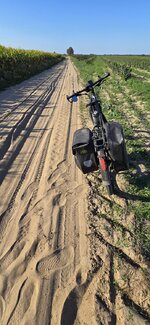Jeremy McCreary
Well-Known Member
- Region
- USA
- City
- Carlsbad, CA
Excellent controlled experiment on the effect of tire pressure and quality on rolling resistance on simulated tarmac and cobbles using a very impressive test rig:
The cobble data has direct application to gravel riding.
Thinking on tire widths, pressures, and rolling resistances has been evolving in recent years. The pros are increasingly going to wider tires at lower pressures on all surfaces, as clearly demonstrated in the 2024 Tour de France.
This trend was already well underway when the 4th edition of Bicycling Science came out in 2020. Excellent discussion of the physics and supporting data there.
As the book points out, an overlooked effect of excessive vibration is excessive rider fatigue. You've no doubt felt this yourself, and you can see it quite clearly in the GCN test rider's body language every time he got off the bike after a cobble run. The higher the tire pressure, the greater the vibration, and the more wasted he looked at the end.
Any vibration reaching the rider is dissipated in the rider's body. Reflexive bracing against the vibration takes up precious rider energy. That's why long rough rides are so exhausting.
So cushier tires aren't just more comfortable. To a point, they're also more rider-efficient on rough surfaces.
My coming Vado SL 5 EQ will come with tubed 700x38 Nimbus tires rated for 50-80 psi. My first mod after deciding to keep it will be to replace them with tubeless tires allowing lower pressures.
The cobble data has direct application to gravel riding.
Thinking on tire widths, pressures, and rolling resistances has been evolving in recent years. The pros are increasingly going to wider tires at lower pressures on all surfaces, as clearly demonstrated in the 2024 Tour de France.
This trend was already well underway when the 4th edition of Bicycling Science came out in 2020. Excellent discussion of the physics and supporting data there.
As the book points out, an overlooked effect of excessive vibration is excessive rider fatigue. You've no doubt felt this yourself, and you can see it quite clearly in the GCN test rider's body language every time he got off the bike after a cobble run. The higher the tire pressure, the greater the vibration, and the more wasted he looked at the end.
Any vibration reaching the rider is dissipated in the rider's body. Reflexive bracing against the vibration takes up precious rider energy. That's why long rough rides are so exhausting.
So cushier tires aren't just more comfortable. To a point, they're also more rider-efficient on rough surfaces.
My coming Vado SL 5 EQ will come with tubed 700x38 Nimbus tires rated for 50-80 psi. My first mod after deciding to keep it will be to replace them with tubeless tires allowing lower pressures.
Last edited:



